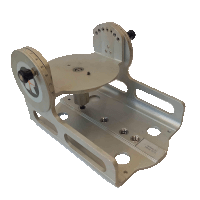Overview
The Riegl VZ-1000 is a high speed terrestrial laser scanner with a maximum range of around 1.4km. The unit is lightweight and compact and is supplied with an external NiMH battery capable of powering the scanner for around 5 hours (other external batteries can be used). RiSCAN PRO software is supplied for collection and processing of point cloud data.
The VZ-1000 uses Riegl’s unique echo digitisation and online waveform analysis to evaluate multiple target echoes. Our scanner has the optional Full Waveform Feature which allows the entire digitised return waveform to be recorded for further analysis of weak signals etc.
The GEF currently has 1 system available for loan. View our schedules to see equipment availability.
Specifications
Scanner
| Model | Riegl VZ-1000 |
|---|---|
| Instrument type | High-accuracy, high-precision ranging based on echo digitization and online waveform processing |
| Data storage | 32Gb onboard flash memory, external USB flash also provided |
| User interface | Onboard colour display and keypad or external PC via WiFi or cable |
| Accuracy | 8mm |
| Precision | 5mm |
| Laser Class | 1 |
| Range | 1.km @ 80%; 520m @ 10% albedo |
| Scan rate | Up to 122,000 points/sec |
| Spot size | 7mm at exit + 0.3mrad divergence |
| Field of view | 360° horizontal, 100° vertical |
| Power supply | 11 - 32V DC |
| Power consumption | 82W typ., 90W max. |
| Battery type | External 18Ah NiMH supplied |
| Duration | Around 5 hours of scanning per battery |
| Operating temp. | 0° to +40°C (lower for short periods) |
| Storage temp. | -10° to +50°C |
| IP Rating | IP64 |
| Altitude limit | Specified to a maximum operating altitude of 2000m |
| Dimensions | 190 x 195 x 370mm |
| Weight | 9.8kg (scanner), 29.8kg (all accessories and case) |
Accessories
Tilt mount
Enables the scanner orientation to be adjusted by up to 90° to scan overhead.
Laptop
A laptop for field processing and optional control of the scanner.
RiSCAN PRO
Software for collection and processing of Riegl scan data.
Packaging and shipping
Carry case
 The system is supplied with a wheeled carry case that contains the scanner plus some accessories.
The system is supplied with a wheeled carry case that contains the scanner plus some accessories.
| Width | 46 cm |
| Depth | 56 cm |
| Height | 27 cm |
| Weight | approx. 30 kg |
Shipping container
 To protect the system from transport damage, we provide an alloy shipping container with foam insert. This alloy container must be used when shipping via courier or as cargo by air or sea.
To protect the system from transport damage, we provide an alloy shipping container with foam insert. This alloy container must be used when shipping via courier or as cargo by air or sea.
| Width | 80 cm |
| Depth | 60 cm |
| Height | 41 cm |
| Weight | approx. 40 kg |
Courier to a UK destination
The GEF(Edinburgh) will ship loan items to the borrower by courier to UK addresses on a next day basis free of charge. It is the borrowers responsiblity to return the equipment to the GEF, on time and at their own expense via any suitable means.
Please note some GEF equipment uses Lithium Ion batteries. You may need to use a road based courier to return equipment to us, please contact us or see our guide to shipping lithium batteries for further information.
Collection from the GEF
Borrowers may collect and return equipment in person from the GEF offices (in Edinburgh and Leicester).
Shipping outside the UK
The GEF(Edinburgh) only ships to destinations within the UK. It is the borrowers responsibility to arrange transportation and all necessary customs paperwork for any temporary export and re-importation to the UK. You may arrange your own courier to collect equipment from our offices.
User training
New users of our GNSS equipment are required to be trained by Facility staff. Training usually takes place during a one day visit to the GEF offices. Previous users are encouraged to attend for refresher training.
Successful applicants will be invited to contact the Facility to arrange a suitable training date, usually close to the start of the project.
Training is free of charge, however applicants will be responsible for making their own way to the Facility.
Frequently asked questions
What is the practical range of the system?
The range will depend on the material being imaged and its orientation to the scanner. Assuming a flat target with a footprint larger than the laser beam and clear atmospheric conditions, a range of approximately 1350m could be expected to a material with an 80% reflectivity and 520m for 10% reflectivity.


